
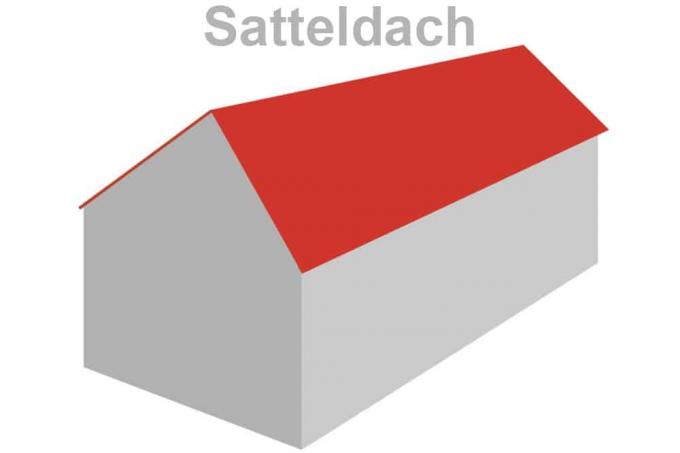
Table of contents
- The Origin of the Gable Roof
- construction and statics
- The rafter roof
- The purlin roof
- The waterproofing
- The thermal insulation
- roof coverings
- The pitch of the roof
- Additional superstructures and installations
- The origin of all changes
- skylight
- rooftop balconies
- dormers
- Advantages and disadvantages
The gabled roof has been found in a wide variety of cultural regions and on a wide variety of building typologies for thousands of years. This already historically established and at the same time versatile use is no coincidence. Because the gable roof impresses with its enormous flexibility and changeability. Everything worth knowing about this archetype of a roof, which is still very relevant today, can be found here.
The Origin of the Gable Roof
The origin of the gable roof is unclear and is already lost in prehistoric phases. It probably arose in numerous cultures, or rather pre-cultural phases, independently of each other. Why this is so can be explained very easily on the basis of its simplest construction forms. If you lean two poles, branches or other supporting elements against each other, you already have a segment of a gabled roof. Covered with a dense material, it offers a surprising amount of space in relation to the effort and at the same time ensures that rainwater is safely drained away. Of course, materials and dimensions have changed significantly over the course of history, but the basic functional principles have remained unchanged to this day. So it is easy to understand that this effective and economical roof shape can still be found on the vast majority of buildings constructed today.
construction and statics
From a structural point of view, there are two systems for the modern gabled roof to ensure the construction is stable erect and meet all requirements for the interior, load-bearing capacity and structure of the thermal insulation and sealing raise.
The rafter roof

The rafter roof is still very close to the shape of two supporting elements leaning against each other, which was already described in the context of the creation. Because with the rafter roof, the opposite rafters support each other and form together with the the load-bearing element underneath, i.e. ceiling or wall, is a self-bracing and self-supporting one Triangle. Arranged in almost any number in a row, these load-bearing triangles result in a gabled roof. The number of statically required elements is manageable with this type of gable roof:
-
Threshold:
forms the lower support of the rafters and at the same time the transition point between the underlying walls or ceilings and the roof construction -
rafters
supporting elements, each in pairs in an opposing arrangement -
bracing
required in the longitudinal direction of the ridge, today mostly as diagonal windbreak strips, or as a statically effective, flat sub-roof
A NOTICE:
From a static point of view, a ridge is not required for a rafter roof. In order to be able to design the building shell cleanly at this upper joint of the roof surfaces, a ridge beam or a vertical ridge board is usually formed. This carries, for example, the ridge tile on tiled roofs, or the hip plate on foil, sheet metal or green roofs.
The purlin roof
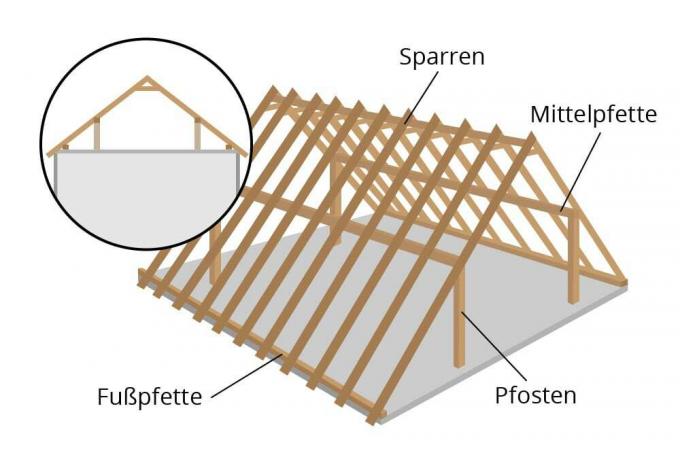
Compared to the rafter roof, the purlin roof appears more complex in its construction, due to the still existing Simplicity and adaptability but still clearly structured and simple compared to numerous others roof shapes. Here, too, the rafters form the core element of the structure. However, they no longer support each other, but only carry the loads of the roof surface onto the supporting structure. The loads are carried by at least two, but usually three, load-bearing points per rafter: sill or toe purlin, middle purlin and ridge. The overview of the statically effective elements is therefore similar, but somewhat longer, than with the rafter roof:
-
threshold
Base of the rafter system and connection to the building below -
central purlin
Medium support and load transfer required for large rafters, either on a wooden structure or on solid interior walls in the attic -
First
Upper support and load transfer point of the rafters, usually placed on gable walls and supports or interior walls positioned in between
A NOTICE:
From a static point of view, the use of a central purlin turns the rafter from a single-span girder resting on two points into a multi-span girder resting on three points. Here, not only is the load distributed over several support points, but the deflection of the individual fields is additionally reduced due to the contribution of the neighboring field. With a central purlin, a rafter can therefore be significantly reduced in the statically required cross-section and, overall, even less material is required than without a central purlin!
The waterproofing
In addition to stability, a roof has always had to offer weather protection. Today, in addition to being impervious to rain, this also includes impermeability to wind and water vapour, which penetrates into the construction from the indoor air and leads to moisture and mold damage can. A gable roof therefore traditionally consists of two sealing levels:
1. Inner sealing
- Task: Diffusion tightness from inside to outside, as well as airtight level
- Usually applied on the inside of the rafter system
- Must be included within the main insulation package
2. Outer waterproofing
- Task: Waterproofing against rainwater
- Created outside the insulation layers
- Can be combined with insulation (e.g. B. soft wood fiber board) or roof covering (e.g. B. sheet metal or foil roof), or as a separate level (e.g. B. tiled roof)
- If the roofing is not completely sealed (e.g. B. bricks) as a drainage layer when rain or snow is forced under the bricks by the wind
The thermal insulation
Independent of roof shape the topic of thermal insulation plays an enormous role today. On the one hand, this results from the legal requirements and constantly rising energy prices. On the other hand, the insulation is only necessary today because attic rooms are usually too Contain living rooms where at most unheated storage and storage rooms were previously provided.

The gable roof is very flexible and cooperative when it comes to thermal insulation: most of the required insulation can be accommodated between the load-bearing rafters. Logically, there can be no insulation where the rafters are, only the insulating effect of the mostly However, the wood used for the rafters is sufficient to achieve adequate insulation performance. This insulation package can be supplemented with insulation layers on the rafter layer or even on its underside. Common insulating materials are these:
For between-rafter insulation:
- mineral wool (formerly glass wool, now rock wool)
- cellulose insulation
- Ecologically sensible insulating materials such as sheep's wool, hemp, etc.
- softwood fiber boards
A NOTICE:
The use of dimensionally stable, non-flexible insulation between the rafters would be possible, but the Joints created by shrinkage and movements of the wooden rafters lead to a significant reduction in the insulating effect to lead.
For above and below rafter insulation:
- Soft insulating materials such as insulation between rafters, then joists for roof construction or interior paneling required
- Plastic foams as dimensionally stable insulation layers on which roof coverings can be applied without a constructive supporting structure
- Dimensionally stable and pressure-resistant soft wood fiber panels
The advantage of insulation between the rafters lies in the relatively small roof structure. If, on the other hand, the rafters are to remain visible, the entire insulation can also be placed on the supporting structure. Depending on the insulating material, it may then be necessary to create a load-bearing level in the form of wooden formwork on which the insulating layer rests.
roof coverings
A gable roof can be created with almost all common roof coverings that are available on the market today. However, traditional building materials can still be used if modern requirements for tightness and thermal insulation are taken into account:
- Historical thatched, straw and reed coverings
- Bricks and concrete roof tiles
- Sheet metal (aluminium, copper, titanium zinc etc.)
- Foil roofs, gravelled or planted with flat slopes
Modern special forms of roofing can sometimes even combine load-bearing, insulating and sealing aspects. If, for example, a sandwich element is used as the roofing, there are of course no load-bearing elements underneath Elements such as rafters, as the element panels are self-supporting between the ridge, middle purlin and threshold can. Insulation and sealing are also omitted here.
The pitch of the roof
The classic pitched roof shape is symmetrical and has the same pitch on both roof surfaces. Possible inclinations depend on the roof shape used and are also subject to fluctuations depending on the fashion and use of the roof space.
Inclinations depending on the covering:
-
Brick and concrete:
depending on the tile up to 15°, some models even 10° possible -
Foil:
0° theoretically possible, but at least 2° according to the flat roof guideline (then no longer a real gabled roof) -
sheet:
at least 5° -
Historical building materials:
There is no minimum technical specification according to the DIN standard, but mostly very steep inclines to avoid rainwater before penetrating the material - often 45° and more, occasionally up to 60 or even 70° discoverable
The steeper the gable roof, the larger the usable roof space. However, as the roof height increases, the peaked roof becomes larger and larger, which itself is hardly usable. Common roof pitches in modern residential construction are often between 25 and 35°, with the roof not directly on the ceiling, but on a piece of wall up to one meter high - the knee wall - rests. However, due to design or urban planning concerns, roofs with higher or lower pitches are still regularly used.
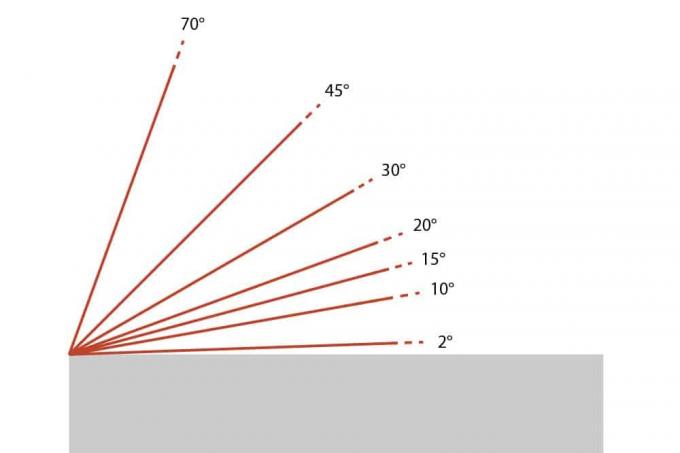
Incidentally, special requirements or local conditions can always lead to a gable roof not being built symmetrically. For example, on a hillside, the roof surface on the mountain side can be flatter in order to provide the wall below with a height that can be used for windows and doors.
Additional superstructures and installations
As simple as the gabled roof itself appears, it can be extended or changed in a variety of ways. Numerous elements that are now indispensable in the roof landscape expand or improve the usability of the rooms located in the attic.
The origin of all changes
Regardless of which element is inserted into a gable roof, this always involves intervention in the load-bearing rafters. In most cases, sections of one or more rafters have to be removed. In order to maintain the load-bearing capacity, a so-called change is then inserted. Alternating timber running transversely between the rafters catch the cut rafters and transfer its loads to the neighboring rafters.
skylight
- Enabling recreation rooms in the roof through lighting and ventilation
- Offer additional space by eliminating the rafter and insulation package under the window area
- Today it is even available floor-to-ceiling and can be displayed as a miniature balcony
- Common forms Top-hung, pivoting or top-hung and pivoting windows
rooftop balconies
- Either from the roof area, or as a loggia entering the roof space
- Very intimate, hard-to-see outdoor area, since good privacy is provided by the roof areas
dormers
- Create additional headroom in the attic
- Create vertical, easily furnished walls instead of sloping ceilings
- Possible in a variety of designs, e.g. B. Saddle roof dormer, trailing dormer, flat roofdormer etc.
- Very good exposure through the use of normal facade windows instead of skylights
Advantages and disadvantages
Now, a gable roof has many advantages, the downside of which is one or two disadvantages. These are recurring:
Advantages
- Simple construction
- Inexpensive to erect due to simple structure and efficient use of materials
- Versatile in design
- Easily expandable and changeable thanks to numerous additions
- Good water drainage due to the inclination of the roof surfaces, so less susceptible to damage in the event of structural weaknesses
- The interior can be easily adapted to use by adjusting the roof pitch
Disadvantages
- Difficult to furnish sloping ceilings
- Comparatively high effort for connections and transitions in the case of supplementary elements
- With a steep incline, the peak of the roof can hardly be used
 Home editorial office
Home editorial office
Learn more about roof / attic
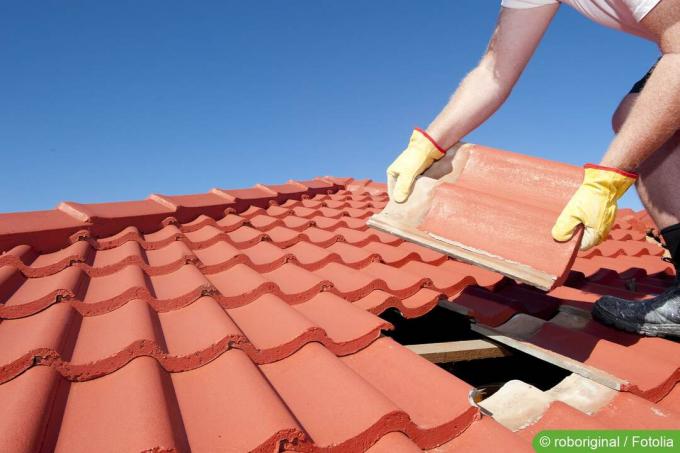
Snow blows under roof tiles: what to do?
Snow drifts often get under the roof tiles when blizzards or strong winds blow them underneath. The moisture often causes damage from meltwater. Air spaces between the roof tiles are to blame. Homeowners should now find out how to counteract this.
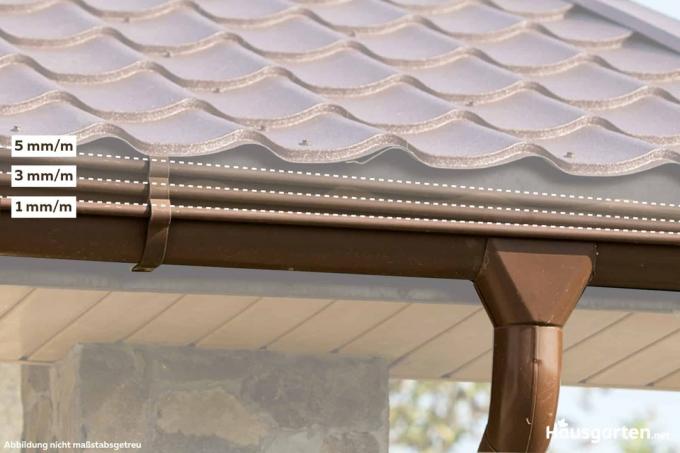
Gutter slope: the ideal gradient
For a gutter to function properly, a slope that has an ideal inclination is required. Various factors have to be taken into account. Before installation, you should find out how the gradient is to be calculated and implemented.
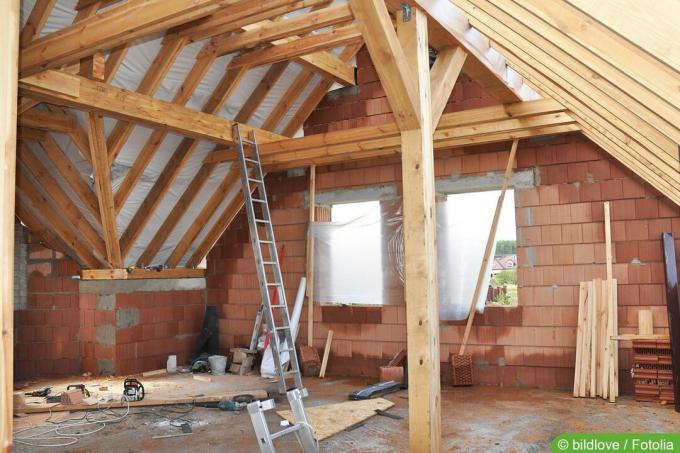
Which attic insulation can be walked on immediately?
Attic insulation effectively reduces heat loss from the building. If the attic is to continue to be used as storage space, the insulation should be accessible as soon as possible. A number of materials can be used for this. They each have advantages and disadvantages as well as different costs.
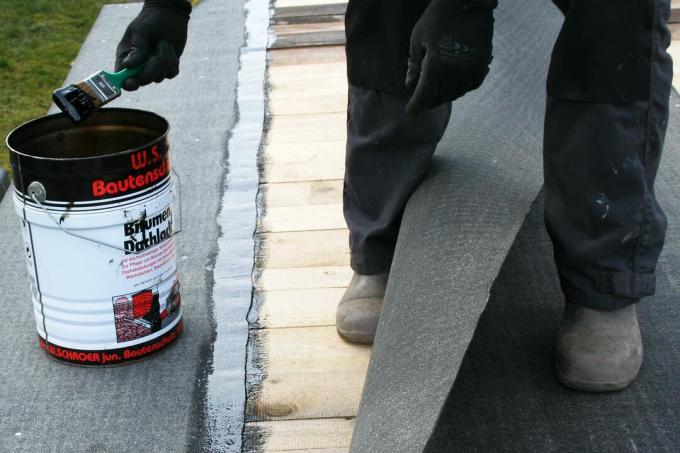
Bitumen stains: 6 removal tips
If you have to process bitumen, you should be careful. The black, viscous mass is sticky and adheres well to clothing, hands and all possible surfaces with which it comes into contact. With our tips you can successfully remove it.
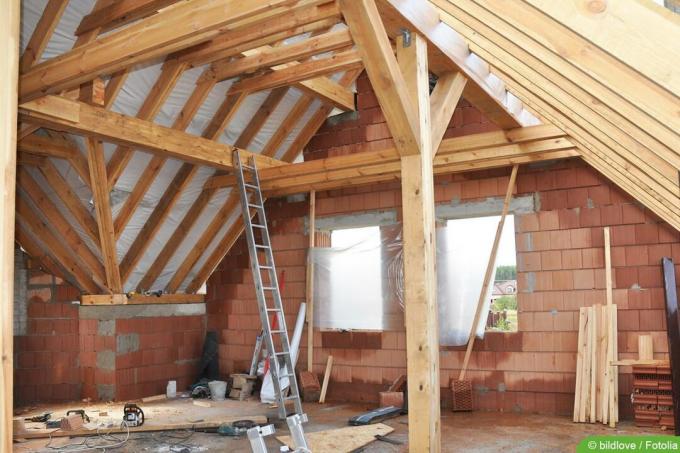
Attic: OSB or Rauspund as roof boarding?
Both OSB and Rauspund boards are suitable as roof boarding. But what are the differences and what is better suited for the attic? Our guide answers these and other questions about the two materials.

Laying a vapor barrier: how far does the vapor barrier have to go?
Laying a vapor barrier is essential in some cases. But how far does the vapor barrier have to be installed, what is it and what are the differences? These and more questions are answered in the following guide.
